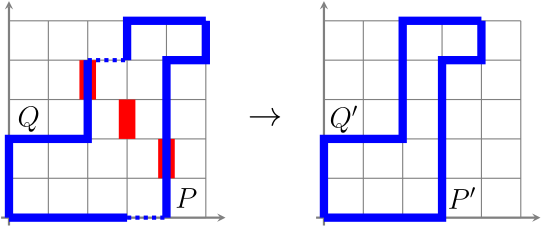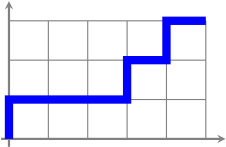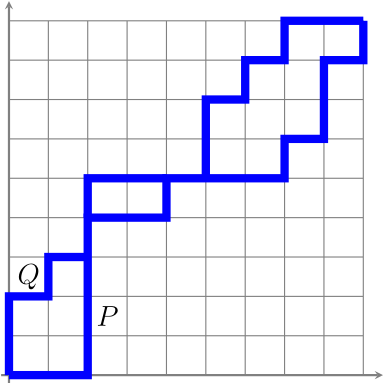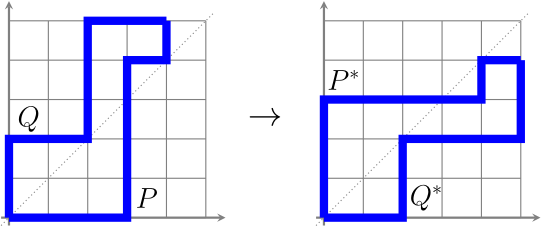From lattice paths to matroids
Lattice paths and Catalan numbers were some of the favourite topics in my recent combinatorics course. And while we didn’t cover them in class, I was reminded of lattice path matroids.
The systematic study of lattice path matroids was initiated by Joe Bonin, Anna de Mier, and Marc Noy. The results I describe here (as well as their proofs) can all be found in this paper by Bonin and De Mier.
A north-east lattice path (I will call them lattice paths for simplicity) is a sequence $v_0 = (0,0), v_1, \ldots, v_\ell$ of points in the lattice $\mathbb{Z}^2$ such that each step $P_i = v_i – v_{i-1}$ is either in the east direction $E = (1,0)$ or in the north direction $N = (0,1)$. As such lattice paths always start at the origin, they are in one-to-one correspondence with words over the alphabet $\{E,N\}$.
There are exactly $\binom{a+b}{b}$ lattice paths to $(a,b)$, as all such paths have $a+b$ steps, and identifying the $b$ north steps among them suffices to describe the path.
Given a lattice path $P$ to $(a,b)$, written as a sequence $P_1P_2\ldots P_{a+b}$ of $a$ east steps and $b$ north steps, we can record the north steps as follows: $$\mathcal{N}(P) = \{i : P_i = N\}.$$
All $b$-element subsets of $[a+b]$ appear as $\mathcal{N}(P)$ for some lattice path $P$ to $(a,b)$; in other words, the set of all $\mathcal{N}(P)$, as $P$ ranges over the lattice paths to $(a,b)$, is the set of bases of the rank-$b$ uniform matroid on $[a+b]$. Lattice path matroids generalise this construction.
Let $P$ and $Q$ be two lattice paths to $(a,b)$. We say that $P \le Q$ if $P$ never goes above $Q$; this defines a partial order on the set of all lattice paths to $(a,b)$. For $P \le Q$, we define the matroid $M[P,Q]$ on $[a,b]$ with set of bases $$\{\mathcal{N}(R) : P \le R \le Q\}.$$
Proposition. $M[P,Q]$ is a matroid.
The matroid $M[P,Q]$ records (the north steps of) all lattice paths between $P$ and $Q$; an arbitrary matroid is called a lattice path matroid if it is isomorphic to $M[P,Q]$ for some $P$ and $Q$. Here are some examples:
- $M[E^aN^b, N^bE^a]$ is the rank-$b$ uniform matroid on $[a+b]$. Here, the first boundary path is the one formed by $a$ east steps followed by $b$ north steps, and the second boundary path is the one formed by $b$ north steps folled by $a$ east steps.
- $M[P,P] \cong U_{b,b} \oplus U_{0,a}$ for any lattice path $P$ to $(a,b)$.
- $M[E^nN^n, (EN)^n]$ is the Catalan matroid with exactly $\frac{1}{n+1}\binom{2n}{n}$ bases.

Properties of $M[P,Q]$ can (in principle) be explained in terms of $P$ and $Q$ alone. We will need the following result later.
Proposition. The element $i$ is a coloop of $M[P,Q]$ if and only if $P_{i-1} = Q_{i-1}$ and $P_i – P_{i-1} = Q_i – Q_{i-1} = N$. The element $i$ is a loop of $M[P,Q]$ if and only if $P_{i-1} = Q_{i-1}$ and $P_i – P_{i-1} = Q_i – Q_{i-1} = E$.
An attractive property of the class of lattice path matroids is that it is closed under duality and minors. Both of these operations have interpretations in terms of lattice paths.
Duality
Let $\mathcal{N}(R)$ be a basis of $M[P,Q]$. Then the complement of $\mathcal{N}(R)$ in $[a+b]$ is a basis of the dual matroid $M[P,Q]^*$: its elements correspond precisely to the east steps in $R$. This inspires the following definition.
For a lattice path $R$, let $R^*$ be the lattice path obtained from $R$ by flipping the roles of north and east steps. If $R$ is a lattice path to $(a,b)$, then $R^*$ is a lattice path to $(b,a)$. Geometrically, $R^*$ is obtained from $R$ by reflecting it in the line $y=x$. It is clear from the geometric perspective that if $P \le R \le Q$, then $Q^* \le R^* \le P^*$, from which it can be shown that the dual of $M[P,Q]$ is again a lattice path matroid.
Proposition. $M[P,Q]^* = M[Q^*, P^*]$.
Minors
Showing that the class of lattice path matroids is minor-closed requires a bit more work. Fortunately, in view of the previous result, it suffices to show that deleting a single element from $M[P,Q]$ results in a new lattice path matroid.
So let $M = M[P,Q]$ be a lattice path matroid and let $i$ be an element of $M$. If $i$ is a loop or coloop of $M$, then $P$ and $Q$ coincide in the $i$-th step; a lattice path representation can be obtained from $P$ and $Q$ by deleting this step from both paths. (When drawing $P$ and $Q$ in $\mathbb{Z}^2$, the resulting disconnected parts of the lattice paths should be connected up again by “sliding” the north-east component one unit to the south (when $i$ is a coloop) or to the west (when $i$ is a loop).)
When $i$ is neither a loop nor a coloop, the bases of $M\backslash i$ are the bases of $M$ that do not contain $i$. In terms of lattice paths, this means that the lattice paths $R$ corresponding to bases of $M\backslash i$ satisfy $P \le R \le Q$ and $R_i – R_{i-1} = E$: we disallow north steps starting from any point $(u,v)$ such that $u+v=i-1$. We obtain lattice paths $P’$ and $Q’$ representing $M\backslash i$ by “merging” the two squares on either side of such north steps. More precisely, we obtain $P’$ from $P$ by deleting the last east step at or before the $i$-th step, and $Q’$ from $Q$ by removing the first east step at or after the $i$-th step. See the figure for an illustrative example.
Proposition. $M[P,Q]\backslash i \cong M[P’,Q’]$.

We conclude that the class of lattice path matroids is closed under taking minors. Joe Bonin identified the excluded minors for the class of lattice path matroids: they comprise the rank-3 wheel and whirl, a rank-3 matroid on seven elements called $R_3$ and its dual, and five infinite families.
The class of lattice paths has many more interesting properties. For example, all of them are transversal matroids and their Tutte polynomials can be computed in polynomial time. I refer to the original papers by Bonin, De Mier, and Noy for this and more.







